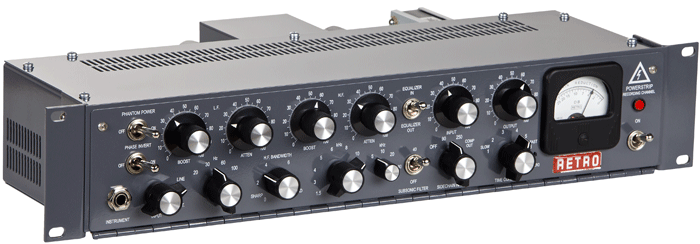|
|
Retro Instruments Powerstrip
|
|
|
 |
| Retro Instruments Powerstrip |
Phil Moore's Retro Instruments' Powerstrip is 'homage' to the sonic beauty and simplicity of the classic, all-tube audio processors of yesteryear. As if transported by a time machine from an era 60+ years ago, Powerstrip sounds like the 'best in class' of those post WWII units because it uses similar circuit Class-A topologies but is also designed and built to be more reliable, consistent and useable for recording any source in these modern times.
The 2U Powerstrip is heavy with Cinemag transformers for microphone and line inputs, massive output transformer (I mistook for the power supply's transformer), all-steel chassis, and full-size toggle switches.
Powerstrip's signal chain starts with a pre-amplifier input section with your choice between microphone, line and the built-in tube DI box. There is a high impedance 1/4-inch input jack feed-thru to your amp and Hi-Z Out jack that makes accessible all the processing power of the Powerstrip "in front" of you guitar or bass amp. Whoa!
Following is a passive program equalizer, a smooth 'tone control' that uses a multi-tapped custom-made inductor for its LCR circuit. This costly component, along with a circuit based on the original Pultec EQP-1A as designed by Eugene Shenk for Western Electric in 1950s, shapes tone like no other EQ and is revered as one of the most beautiful sounding equalizer circuits ever.
Retro Instruments has an expanded the choice of mid-range frequencies with 1.5kHz, 6kHz, and 14kHz positions. And like the Pultec, Powerstrip's EQ allows for simultaneously boosting and cutting the same frequency producing the classic resonant peak usually only found in analog synth filters.
Powerstrip follows the equalizer section with a variable-mu tube compressor circuit that references both Altec's 436B and Rein Narma's Fairchild 660/670 limiter units also designed in the 1950's. But those designs didn't have Powerstrip's side-chain high pass filter with a choice between 90Hz and 250Hz corner frequencies. Compressing less in the low frequencies allows for more compression of the upper frequencies at the same time; this is a popular feature R&B and Rap/Hip Hop music mixers especially love! A low-end theory I embrace.
The newly added Soft mode adds a colorful level-dependent 2nd harmonic amplitude distortion to the input stage that works well for direct bass or even direct guitars that were just too clean sounding otherwise. The VU meter reads gain reduction only--I love that! You have the entire meter's range to use and actual recording level is more accurately indicated on the DAW's meter.
I also "get" the combo input gain/compressor Input knob too. Phil combines (what are usually separate controls--sometimes on separate processors) both the input pre-amp gain with the compression amount. Compression is (by definition) totally dependent on the source's level coming into a compressor--threshold controls didn't appear on the front panels of compressor/limiters until later in audio history--we don't need no stinking threshold controls.
This is brilliant and a tribute to a careful and thoughtful analog circuit design and proper component choice that works well and nearly eliminates the "dial in" time to setup gain and compressor settings to capture fleeting moments of unique musical performances that often go unrecorded and lost forever. I found this feature to work for just about any source or microphone; I had no problems recording my low output AKG D190E dynamic to my modern and super high output Audio-Technica AT-4081 active ribbon. Using no additional boost from the EQ section.
Since the Input control and final Output level control are right next to each other, it is easier to reconcile and set the amount of Input level vs. gain reduction. This has always been a two-handed juggling act for recording engineers and at least now the two controls are next to each other on the same front panel instead of inches or feet away such as the case when using the console's mic gain knob with an 1176LN back in the rack.
I think Retro Instrument's Powerstrip is an awesome and powerful tool that requires some 'woodshedding' and experimenting in the studio to use and learn its full potentiality. I've turn it on three times in three weeks and each time I've come up with new applications to try it out on.
If subjective terms like "vibey, or "colorful" are requirements of your recording gear and are not listed in the spec sheet, Retro Instruments Powerstrip Recording Channel is for you.
Check: www.retroinstruments.com/powerstrip.php for much more.
|
|
|